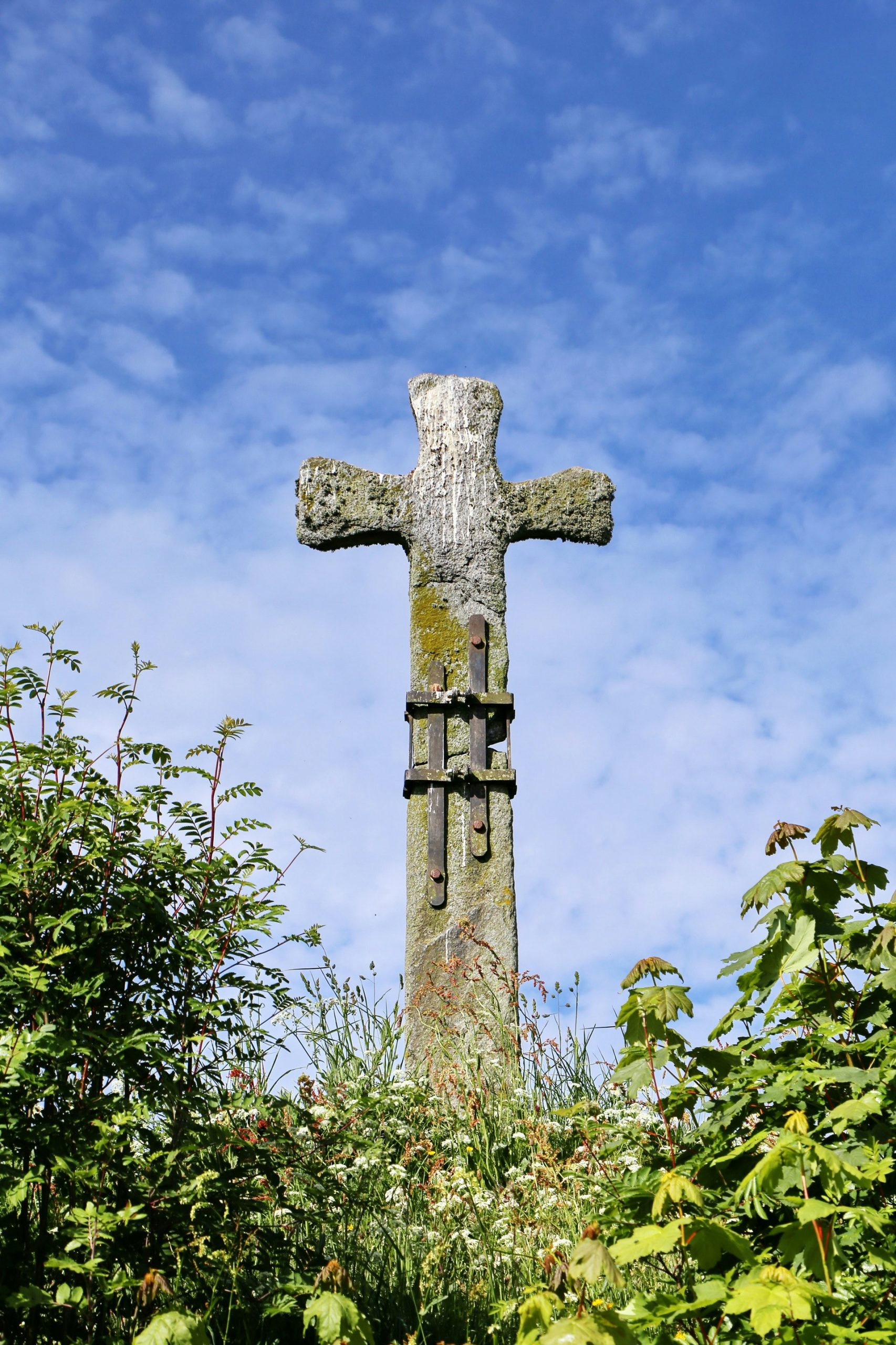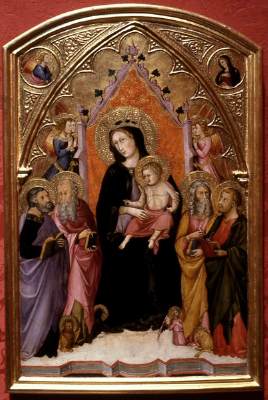Signs and symbols: The sign of the Cross

Let us then not be ashamed of the Cross of our Saviour, but rather glory in it. For the word of the Cross is unto Jews a stumbling-block, and unto Gentiles foolishness, but to us salvation: and to them that are perishing it is foolishness, but unto us which are being saved it is the power of God. For it was not a mere man who died for us, as I said before, but the Son of God, God made man. (St. Cyril of Jerusalem, Doctor of the Church, Catechetical lesson #13, para. 3)
In first century Rome, the most horrific death one could experience was crucifixion. The Romans had developed ‘tricks of the trade’ that inflicted the most pain possible and for as long as possible. The cross was a repugnant image of hate and, thus, an image hated by all.
But the first followers of Christ knew He had transformed this image, itself the epitome of evil, into an instrument of salvation. For them, the cross reminded them of God’s love for them, His absolute power over evil and death, and that not even death itself could separate them from the love of God in Christ Jesus (c.f. Romans 8:38-39). As Jews, these followers of Jesus already had signs and symbols which God instructed them to take on. In particular, the great command or Shema of God is found in Deuteronomy 6:5, “Therefore, you shall love the Lord, your God, with your whole heart, and with your whole being, and with your whole strength.” The manner in which this command was to be lived out was “Bind them on your arm as a sign and let them be as a pendant on your forehead. Write them on the doorposts of your houses and on your gates.” (v. 8-9). So the observant Jew would wear tefillin, small boxes with scrolls of God’s key precepts. One was placed on the head above the center of the eyes and the other on the arm with straps wrapped to the hand. This signifies keeping God’s precepts in one’s thoughts and actions, the mind and heart.
Now these Jews become followers of Jesus, who extended the Shema to include our minds (Mark 12:30) and who gave them their own prayer that signified they belonged to Him (the Our Father, Matthew 6:9-13). But He also gave them the cross as the means to salvation. Thus, for the first Christians, the sign of the cross became the manner in which to mark oneself signifying adherence to God’s precepts.
“Let us not then be ashamed to confess the Crucified. Be the Cross our seal made with boldness by our fingers on our brow, and on everything; over the bread we eat, and the cups we drink; in our comings in, and goings out; before our sleep, when we lie down and when we rise up; when we are in the way, and when we are still. Great is that preservative; it is without price, for the sake of the poor; without toil, for the sick; since also its grace is from God. It is the Sign of the faithful, and the dread of devils: for He triumphed over them in it, having made a show of them openly (Colossians 2:15); for when they see the Cross they are reminded of the Crucified; they are afraid of Him, who bruised the heads of the dragon. Despise not the Seal, because of the freeness of the gift; out for this the rather honour your Benefactor.” (St. Cyril, para. 36)
But it meant much more to them than the tefillin and it should to us too. For the first followers of Jesus, and for us, the sign of the cross is more than a symbol of a commitment. It is prayer to each person of the Trinity: Father, Son, and Holy Spirit. As Trinitarian prayer, it must be said with precision or it risks addressing our Triune God in a manner that claims a false nature for Him: in the name of THE Father, and THE Son, and THE Holy Spirit, three distinct persons consubstantial in one God. With the sign of the cross, we are marking ourselves as His in a manner that expresses our belief in Him; one priest explained that like gangsters tag their territory, God marks our soul as His (as Cyril said, we are sealed). It is an act of faith that encompasses our whole body. In fact, we are enacting the very word itself for “mark” in Hebrew is the letter ‘taw’ and shaped like a cross (in Greek, tau, and also cross-shaped). We separate our body from the enemy and the world by marking it. It is the “sign of the living God” in scripture (Revelation 7:2, 3, 9:4, 14:1). It also is a renewal of our baptismal vow by which (as Jesus commanded) we were consecrated to God in the names of each Person of the Trinity (Matthew 28:19). It is very personal, and we are speaking to God when we voice it.
“St. Augustine says that by the sign of the cross and the invocation of the Name of Jesus all things are sanctified and consecrated to God.” (1.4.1)
The mystery of the cross itself is revealed by the Apostles. We see it named numerous times in Paul’s letters (c.f. Ephesians 2:16; Hebrews 12:2; I Corinthians 1:17, 8:18; Galatians 2:19, 6:14; Philippians 3:18; Colossians 2:14 ). For St. Paul it is not just a reminder of Christ’s act but of the mystery behind it in His sacrifice and Passion. As prayer, we enter this mystery when signing ourselves in an intentional manner.
Historical records demonstrate use of pieces of the true cross (discovered in A.D. 326) for veneration. In fact, as early as A.D. 380, on Good Friday the Christians would venerate the cross with a kiss just as we do today. We do not worship it nor assign magical powers to it. Rather, our kiss is a profound realization of what Christ did for us on it. The same follows for when we sign our body. The sign of the cross was such a prominent symbol of Christianity (even under persecution) that the 4th century Roman Emperor Julian the Apostate “made it a crime for Christians to adore the wood of the Cross, to trace its form upon their foreheads, and to engrave it over the entrances of their homes” (note how the Jewish practice of marking their doorposts with the Shema was changed by Christians marking it with the Cross). When we mark ourselves, our homes, an object with the cross, in spiritual warfare, or to transform ordinary water into Blessed, its power lies NOT within us but within the Person of the Holy Spirit and His choice to respond to our request. It is an act of consecration to God, a giving of it to Him.
In his dialogue with the Jew named Trypho, St. Justin Martyr writes around A.D. 130 of the use of the sign of the cross. He explains how Moses was a prefigurement of this, for while Joshua battled Amalek, Moses held his arms out in prayer, thereby taking the shape of the Crucified One (Exodus 17:8-13). “For it was not because Moses so prayed that the people were stronger, but because, while one who bore the name of Jesus (Joshua) was in the forefront of the battle, he himself made the sign of the cross. For who of you knows not that the prayer of one who accompanies it with lamentation and tears, with the body prostrate, or with bended knees, propitiates God most of all?” (Dialogue with Tripho, ch. 90). The cross leads us to the Crucified one.
The use of the sign of the cross began with the first Jewish followers of Jesus and persists to this very day.
“Be like Jesus who trusted His Father to raise Him from the dead.” (Homily of Fr. Stephan Dass)
This leads to the Feast of Christ our King which we celebrate this Sunday. Jesus is calling us to join Him in His project: to bring souls to salvation in Him. When He came to the earth as that simple, beautiful infant child, the world was a mess. When He ascended into Heaven taking His rightful place as King over the cosmos, the world was still a mess. He didn’t come to fix the world; He came to offer it salvation. It is the true nature of love to invite love in return rather than impose love upon the beloved. Thus, He still awaits souls to accept His invitation to eternal love and freedom, beginning with us. Accept the invitation.
Ad Majorem Dei Gloriam 😊
P.S. …
- The Battle for Interior Stillness: “If God is the center of my life, then why am I always the center of my own thoughts?” Outstanding discussion on difficulties in prayer with Fr. Ambrose and Fr. John Henry of St. Michael’s Norbertine Abbey. His upcoming book will be a must read too! https://theabbotscircle.com/post/the-battle-for-interior-stillness
- com is hosting a 33-day dedication to our Eucharistic Jesus featuring the guidance and insights of Dominicans Fr. Jesse Maingot and Fr. Ignatius Schweitzer. Sign up here https://spiritualdirection.com/his
- Shalom World is offering free, family friendly, faithful entertainment to prepare for Christmas https://watch.shalomworld.org/network/68fb6cc14d6df4f74be6b4a8/Category
- And the Institute of Catholic Culture prepares us for the Feast of the Presentation of the Blessed Virgin Mary tomorrow https://instituteofcatholicculture.org/feast-of-the-presentation-of-the-blessed-virgin-mary/
(Image by Mark Konig on Unsplash)

Thank you for caring and sharing appropriately...
Consecrated to the Sacred Heart of Jesus through the Immaculate Heart of Mary. Except where noted, all design, writing and images ©2024 by Debra Black and TheFaceofGraceProject.com. All Rights Reserved. No part of this website may be reproduced, distributed or transmitted in any form or by any means, including downloading, photocopying, recording, or other electronic or mechanical methods, without the prior written permission of the publisher, except in the case of brief quotations embodied in critical reviews and certain other noncommercial uses permitted by copyright law. For permission or to report violations please email: thefaceofgraceproject@gmail.com
